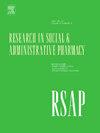心力衰竭指导药物治疗的依从性和持久性:基于电子医疗数据的研究系统综述
IF 2.8
3区 医学
Q1 PUBLIC, ENVIRONMENTAL & OCCUPATIONAL HEALTH
Research in Social & Administrative Pharmacy
Pub Date : 2025-07-17
DOI:10.1016/j.sapharm.2025.07.005
引用次数: 0
摘要
背景:心力衰竭(HF)显著影响全球发病率、死亡率和医疗保健费用。有效的治疗包括多种指导的药物治疗,如-受体阻滞剂、血管紧张素转换酶抑制剂、矿皮质激素受体拮抗剂、血管紧张素受体-neprilysin抑制剂和钠-葡萄糖共转运蛋白2抑制剂。然而,心衰患者的药物依从性和持久性往往不是最佳的,对临床结果产生负面影响。本系统综述评估了心衰患者的药物依从性和持久性及其与临床结果的关系。方法:遵循PRISMA指南进行系统综述,评估1990年至2024年间发表的电子医疗数据库的观察性研究。纳入了报告心衰药物治疗依从性或持久性的研究,通过药房索赔或电子健康记录来衡量。主要依从性(初始配药),次要依从性(继续补充)和持久性(持续时间直到停药)进行了分析。结果:回顾了52项研究,涉及2,001,178例心衰患者。没有研究充分评估最初的依从性。次要依从性主要使用覆盖天数比例或药物持有比进行评估,依从性通常低于最佳水平(结论:HF患者的药物依从性和持久性仍然低于最佳水平,特别是复杂,多药物方案和长期治疗。改善依从性与更好的临床结果相关,强调需要标准化的依从性措施和有针对性的干预措施来提高患者的预后。本文章由计算机程序翻译,如有差异,请以英文原文为准。
Adherence and persistence to heart failure guideline-directed medical therapy: A systematic review of studies based on electronic healthcare data
Background
Heart failure (HF) significantly impacts global morbidity, mortality, and healthcare costs. Effective treatment involves multiple guideline-directed medical therapies, such as beta-blockers, angiotensin-converting enzyme inhibitors, and mineralocorticoid receptor antagonists, angiotensin receptor–neprilysin inhibitor and sodium-glucose cotransporter 2 inhibitors. However, medication adherence and persistence in HF patients are often suboptimal, negatively influencing clinical outcomes. This systematic review assesses medication adherence and persistence among HF patients and their relationship to clinical outcomes.
Methods
A systematic review following PRISMA guidelines was conducted, evaluating observational studies utilizing electronic healthcare databases published between 1990 and 2024. Studies reporting adherence or persistence to HF pharmacological treatments, measured by pharmacy claims or electronic health records, were included. Primary adherence (initial dispensing), secondary adherence (continued refilling), and persistence (duration until medication discontinuation) were analyzed.
Results
Fifty-two studies involving 2,001,178 HF patients were reviewed. No studies adequately assessed primary adherence. Secondary adherence was predominantly evaluated using Proportion of Days Covered or Medication Possession Ratio, with adherence generally below optimal levels (<80 %). Medication adherence declined significantly with increased regimen complexity and over extended periods. Persistence rates were notably lower in long-term follow-ups, especially with mineralocorticoid receptor antagonists. Higher medication adherence and persistence consistently correlated with reduced hospitalizations, emergency department visits, and mortality rates. Methodological heterogeneity across studies precluded the feasibility of a meta-analysis.
Conclusions
Medication adherence and persistence among HF patients remain suboptimal, particularly with complex, multi-drug regimens and prolonged treatments. Improved adherence was correlated with better clinical outcomes, underscoring the need for standardized adherence measures and targeted interventions to enhance patient outcomes.
求助全文
通过发布文献求助,成功后即可免费获取论文全文。
去求助
来源期刊

Research in Social & Administrative Pharmacy
PUBLIC, ENVIRONMENTAL & OCCUPATIONAL HEALTH-
CiteScore
7.20
自引率
10.30%
发文量
225
审稿时长
47 days
期刊介绍:
Research in Social and Administrative Pharmacy (RSAP) is a quarterly publication featuring original scientific reports and comprehensive review articles in the social and administrative pharmaceutical sciences. Topics of interest include outcomes evaluation of products, programs, or services; pharmacoepidemiology; medication adherence; direct-to-consumer advertising of prescription medications; disease state management; health systems reform; drug marketing; medication distribution systems such as e-prescribing; web-based pharmaceutical/medical services; drug commerce and re-importation; and health professions workforce issues.
 求助内容:
求助内容: 应助结果提醒方式:
应助结果提醒方式:


